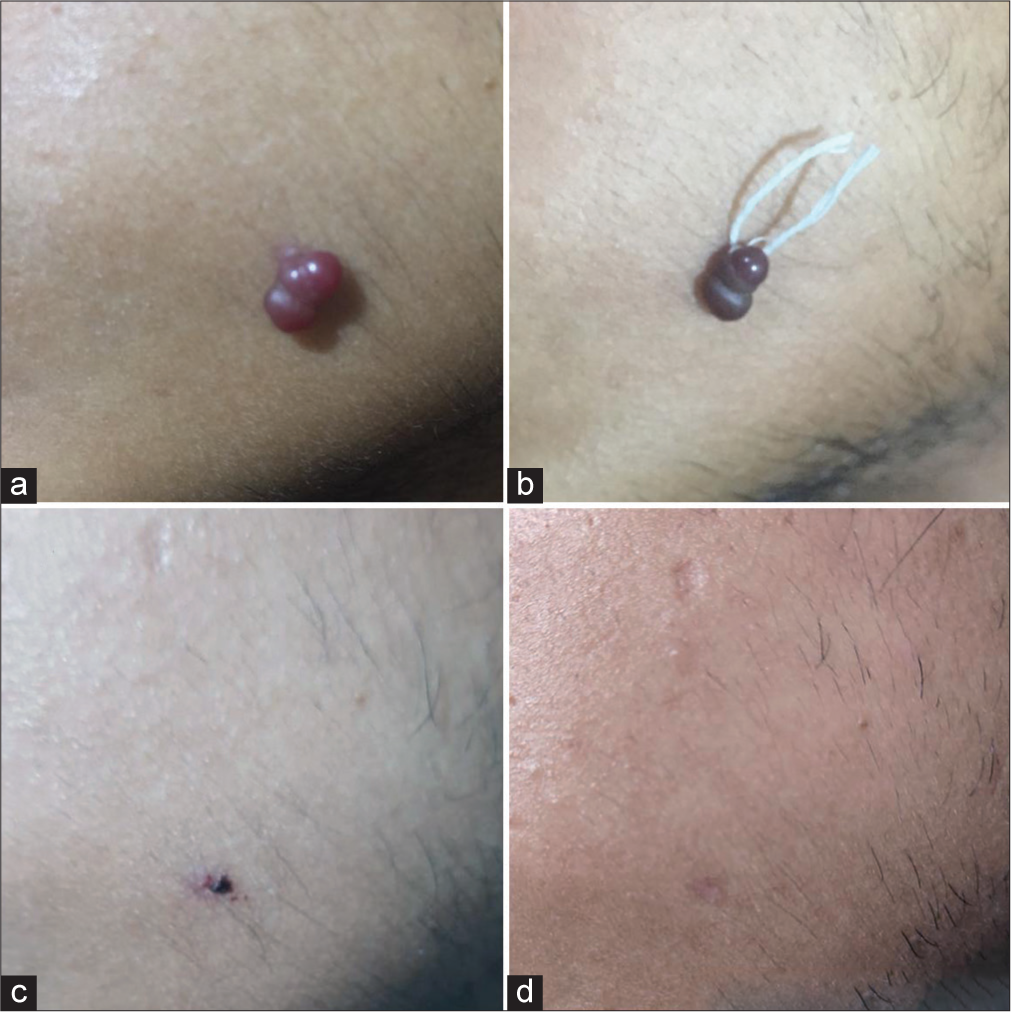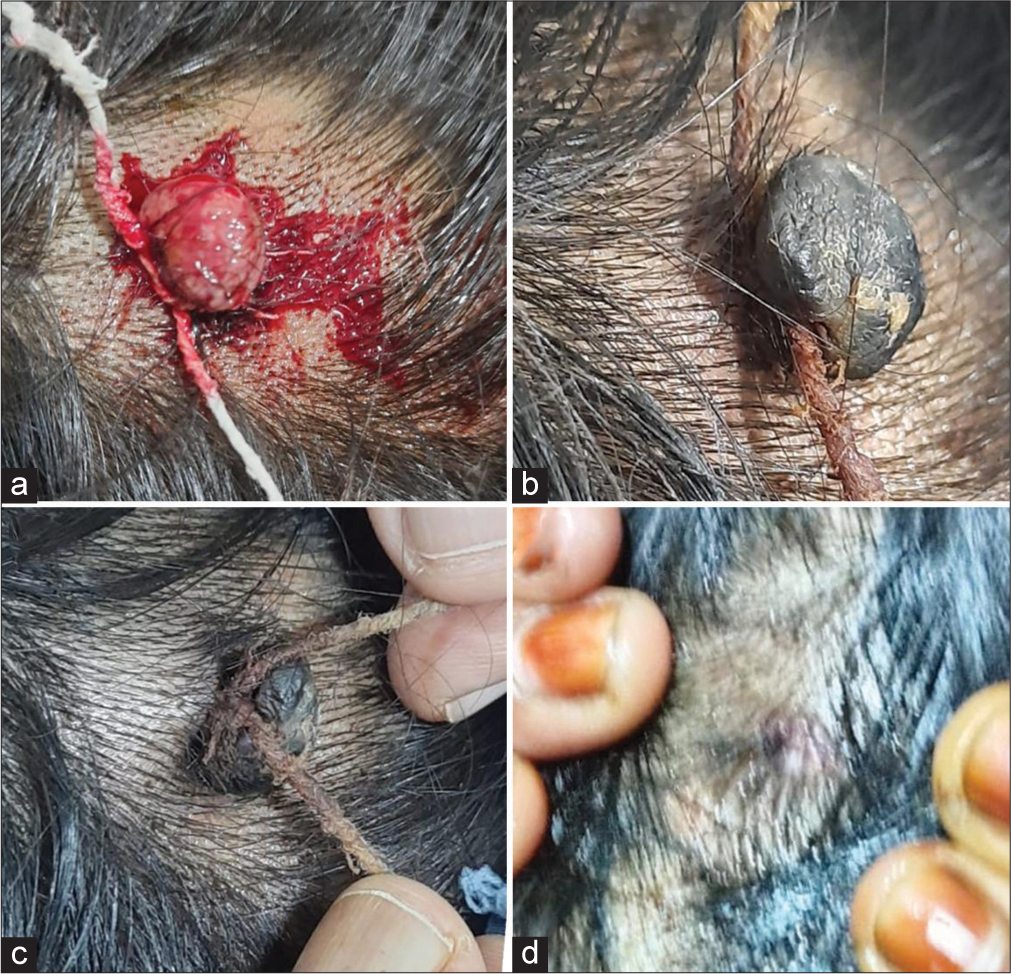Translate this page into:
Surgical pearl: A simple, fast, and less hemorrhagic technique of ligation for treating pedunculated granuloma pyogenicum

*Corresponding author: Muhammed Mukhtar, Department of Dermatology, Mukhtar Skin Centre, Katihar, Bihar, India. drmmukhtar20@gmail.com
-
Received: ,
Accepted: ,
How to cite this article: Mukhtar M. Surgical pearl: A simple, fast, and less hemorrhagic technique of ligation for treating pedunculated granuloma pyogenicum. CosmoDerma. 2024;4:125. doi: 10.25259/CSDM_141_2024
PROBLEM
Granuloma pyogenicum (PG) is a common benign hemorrhagic vascular tumor that can bleed even with minor injury. Excision, electrosurgery, cryotherapy, sclerotherapy, laser therapy, and ligation are all good treatment options. However, ligation therapy is a simple, fast, cost-effective, non-invasive, and non-hemorrhagic procedure that does not require sterilized instruments, topical or intralesional anesthesia, or any assistance.[1] It has less effect on the surrounding skin and underlying structure; thus, it heals rapidly and has excellent esthetic outcomes. Although there is a risk of bleeding from the feeder blood vessel during the procedure, if the thread is thin and the ligation is too tight, compression or a compression bandage is required, which increases the duration of the procedure. This method may be useless if the ligation is unable to constrict the feeding vessels of sessile PG.
SOLUTION
To solve the laceration, bleeding, and recurrence of the lesion, we used a small thick thread made of gauze or soft cotton thread. Four to six threads of a 6-inch wide gauze are removed or a thin strip of gauze piece having four to six threads is cut and twisted clockwise or anti-clockwise to form a strong, thick, slightly rough thread. Following that, an ointment is given to the thread to make it a little slippery, allowing the half knot to be created with ease. The knot is gently put at its base to compress, not lacerate, the feeding vessels, as indicated by the color change of the lesion. The extra thread is cut, leaving 2–3 cm on both ends to tighten the knot and increase compression to the feeding vessels as needed. Following that, a topical sclerosing agent such as hypertonic saline (HS) is applied 2–3 times/day at the base of the lesions and on the surface if they bleed due to minor trauma. After seeing the red color of the lesion, the attendants are told to tighten the ligation at home as needed. The lesions fall within 5–10 days [Figures 1a-d and 2a-d]. After this, HS is used topically for 2–3 weeks for sclerotherapy of the feeding arteries of the PG stump to prevent bleeding and recurrence. It serves as an anti-infective and dehydrating agent on the tissue, as well as a sclerosing agent on the lacerated pedicle’s feeding vessels, increasing the effect of the ligation while limiting hemorrhage at the site. HS also works on the PG pedicular stump’s feeding channel, preventing its recurrence. Thus, simple half-knot ligation with HS is a cost-effective, fast, easy, and less hemorrhagic method of treating PG. With extended use of HS on recurrent traumatized or excoriated, the stump of a PG lesion may hinder healing, and cause skin scarring. In that situation, HS should be discontinued and a topical ointment-based antibiotic used until the lesions heal.

- (a-d) The ligation of the granuloma pyogenicum on face and alterations in the lesion and at the site within 1 week.

- (a-d) The ligation of the excoriated hemorrhagic granuloma pyogenicum on scalp and alterations in the lesion and at the site after 10 days.
Ethical approval
The Institutional Review Board approval is not required.
Declaration of patient consent
The authors certify that they have obtained all appropriate patient consent.
Conflicts of interest
There are no conflicts of interest.
Use of artificial intelligence (AI)-assisted technology for manuscript preparation
The authors confirm that there was no use of artificial intelligence (AI)-assisted technology for assisting in the writing or editing of the manuscript and no images were manipulated using AI.
Financial support and sponsorship
Nil.
References
- Surgical pearl: Ligation of the base of pyogenic granuloma-an atraumatic, simple, and cost-effective procedure. J Am Acad Dermatol. 2003;49:509-10.
- [CrossRef] [Google Scholar]





